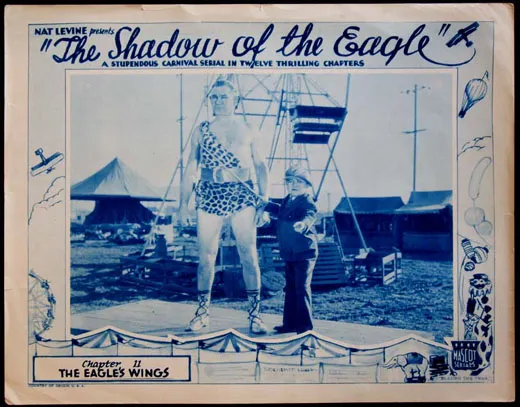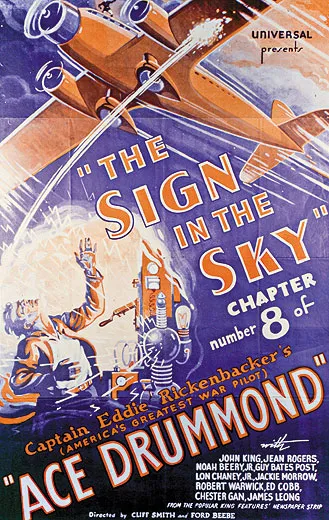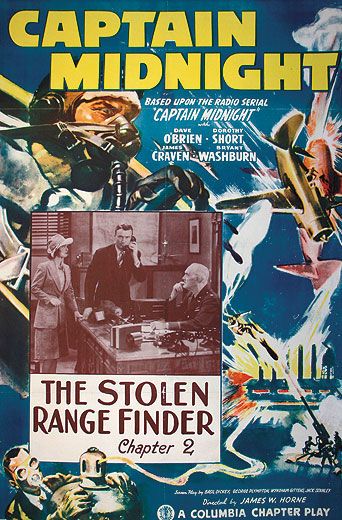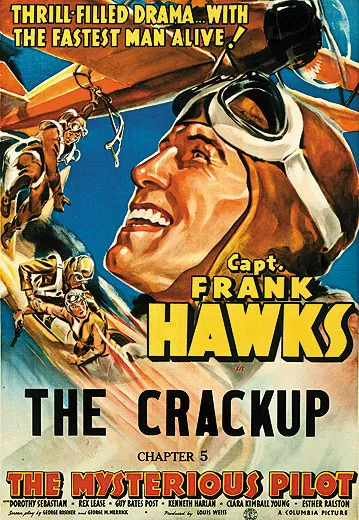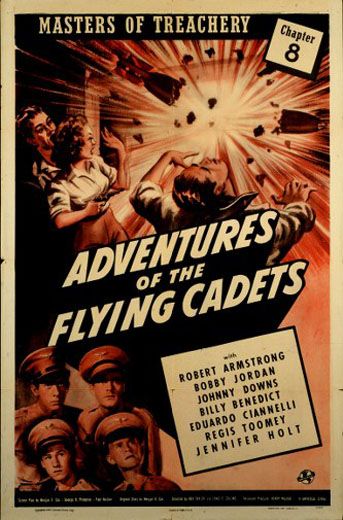Thrills! Chills! Mystery in the Air!
In the 1930s and ’40s, heroic pilots engaged enemy aircraft — every Saturday morning.
/https://tf-cmsv2-smithsonianmag-media.s3.amazonaws.com/filer/Thrills_Chills_FLASH.jpg)
Was it Lindbergh and his solo flight across the Atlantic or dashing stunt pilot Frank Clarke who finally made airplanes the stars of Saturday morning movie serials? In the first serial with an aviation theme, the 1928 Eagle of the Night (a title echoing Charles Lindbergh’s nickname “Lone Eagle”), Clarke continued a tradition he’d begun in the 1921 silent film Stranger Than Fiction, in which he flew a Curtiss Canuck biplane off the roof of a 10-story building. After Clarke blazed the trail, almost 20 aviation-themed serials were made. Many of the kids who watched the Saturday morning thrillers would have those scenes in mind when they trained a few years later for aerial battle in World War II.
Nearly forgotten today, movie serials were wildly popular with audiences from the 1910s through the 1950s. The Edison Company produced the first serial (What Happened to Mary?) in 1912, and the format’s immediate success led to dozens of copycats, including The Perils of Pauline, which helped introduce the cliffhanger as a plot device. Most serials ran for 12 to 15 episodes, letting the plot slowly unfold every week over several months.
Directors of aviation serials were eager to hire real pilots. The 1937 serial The Mysterious Pilot starred the record-setter Frank Hawks, billed as the “fastest airman in the world.” (He died in 1938, shortly after the serial’s completion, when he crashed his Gwinn Aircar.) And the first Tailspin Tommy, in 1934, starred Maurice “Loop-the-Loop” Murphy (world-record holder for 120 consecutive loops), a stunt pilot from Howard Hughes’ 1930 film Hell’s Angels.
But the serials’ realism didn’t extend to aircraft: A single scene might feature an actual airplane, a model, and stock footage—all of different aircraft.
The era of serials featuring a dashing aviator came to an end in 1952, with Columbia Pictures’ Blackhawk. While less than 10 percent of Americans had taken even one commercial flight by then, putting pilots on the big screen no longer seemed the stuff of adventure. And so, to recapture the same wonder inspired by early aviation, serial storylines turned to space pilots and interplanetary travel.
ACE DRUMMOND
Based on a comic-strip representation of American World War I ace Captain Eddie Rickenbacker, the character of Ace Drummond is as suave a hero as you’ll find in aviation serials. Drummond, writes Rickenbacker biographer W. David Lewis, “was essentially a projection of Rickenbacker’s inner vision of himself, living out a fantasy life based on his own experiences and his faith in technology as the master key to progress.” John King, a vocalist who bursts into song during each installment, plays Drummond in this 1936 serial, in which an evil mastermind known as “the Dragon” tries to drive International Airways and its Clipper Ship air service out of Mongolia.
“For movie audiences at the time,” says Mark Taylor, the motion picture archivist at the National Air and Space Museum, “the Clippers represented the leading edge of air transportation, similar to showing the Boeing 747 or Concorde in movies of the 1970s and 1980s. In both cases, these aircraft represented the epitome of luxurious long-range air transportation.”
Best line:
Ace Drummond to Peggy Trainor:
“We’re gonna crash! Duck under the cowling!”
SKY RAIDERS
In this 1941 serial, pilots in a World War I daredevil squadron, the Sky Raiders, have reorganized as aircraft manufacturers under the leadership of Captain Robert Dayton, their former commander. They’ve developed a pursuit ship (which appears to be some kind of modified Ryan with a Ranger engine) and a bomber that is very loosely based on the Bell XFM-1/YFM-1. Ruthless international spy Felix Lynx is determined to obtain both for an unnamed foreign government. He’s aided in his quest by the use of a Kellett KD-1 autogiro, which he keeps parked on the roof of his luxurious penthouse office for fast getaways.
“Autogiros were much in the news for rooftop operations the year before this was released,” says Roger Connor, the Museum’s vertical-flight curator. “Given that this was a Universal production, they had ready access to newsreel footage to splice in. [There was a lot of] attention surrounding Post Office autogiro airmail trials, most notably in Philadelphia—which also featured a KD-1, and which may be the one seen in the serial.”
Best line:
Captain Robert Dayton to Mary Blake, his gal Friday:
“When I come back, remind me to fire you.”
JUNIOR G-MEN OF THE AIR
The Dead End Kids and the Little Tough Guys save the day in this 1942 serial celebrating the efforts of “wide-awake, energetic young civilians” who expose a nest of dangerous fifth columnists working within the United States. “Ace” Holden, played by actor Billy Halop, leads a gang of scruffy juveniles who work at his father’s junkyard. His brother, Eddie (Gene Reynolds), the brains of the group, has designed a muffler for airplane engines; he plans to give the technology—which would enable entire bomber squadrons to fly silently—to the U.S. government. But the treacherous Black Dragon Society (“a dangerous alien organization working right here in our very midst, to pave the way for the conquest of the United States”) has other plans. A dated biplane, possibly a 1930s Great Lakes trainer, makes an appearance as the Black Dragon Society’s “hot new pursuit ship.”
Best line:
Ace Holden: Where are you takin’ me?
Bad guy: Up to about 12,000 feet — and then you’re going to try a little cloud walkin’.
CAPTAIN MIDNIGHT
Derived from the popular radio program of the same title, which was a favorite with the U.S. Army Air Corps, Captain Midnight was the code name of Captain Red Albright, a former World War I Army pilot engaged in a “one-man war against crime.” In this 1942 serial, scientist John Edwards invents a range finder and becomes a target of the evil Ivan Shark, who heads a mercenary organization. Captain Midnight comes to Professor Edwards’ rescue, of course, with his trusty sidekicks Ikky and Chucky. Shark flies a Stinson Model A Trimotor, an aircraft ideal for a villain: its double-tapered wing and forward-raked windscreen gave it a strikingly sinister appearance.
Best line:
Bad guys as they enter Professor Edwards’ home:
“The job will be easy if there aren’t any screaming women about.”
THE ADVENTURES OF SMILIN' JACK
Although the comic strip was loosely based on the dashing air racing pilot Roscoe Turner, the movie serial made do with a former child model for Buster Brown shoes. In this 1943 serial, Smilin’ Jack works with the Chinese government to stop the Black Samurai, a covert Japanese spy ring run by Fraulein Von Teufel (German for “Miss Devil”), from learning the route from China to India through the fictional mountain kingdom of Mandan.
To outsmart a Black Samurai agent bent on hijacking their Fairchild 24, Smilin’ Jack and Janet Thompson use Pig Latin; little do they know that more agents follow closely behind in a Lockheed Vega. In a nice use of stock footage, Smilin’ Jack is escorted into Chungking by the Flying Tigers.
Best line:
In an effort to console the Mandan governor, whose first trip out of the kingdom isn’t going according to plan, Gertrude Muller points out,
“Well, it surely hasn’t been monotonous. Shot down by Japs, imprisoned in a sub tender, and finally escaping in this eggshell.”
HOP HARRIGAN
In this post-Hiroshima serial from 1946, Hop Harrigan and sidekick mechanic Tank Tinker run a small charter service at Blakefield Airport. Although they’ve just landed a cushy job hauling gold from the nearby Atlas Mine, they decide to subcontract it in order to fly mad scientist Dr. Tobor to his mountain lair, where he has developed a new power source more potent than atomic energy. They’ll soon find out that the villain—the oddly named “Chief Pilot”—is also after the deadly ray. With this ray, Dr. Tobor powers his lightning-fast Mystery Plane (a PT-26 with the prop removed). It’s doubtful that Hop and his employer, Mr. Arnold, will be able to keep up in their respective Stinson 108 and Bellanca 14.
Best line:
First bad guy: Who fired those shots?
Second bad guy: Somebody with a gun.
Associate editor Rebecca Maksel is a fan of Captain Midnight.
